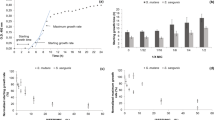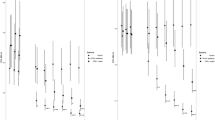Abstract
The aim of this study was to determine the optimal concentration of Korean propolis against clinical isolates of mutans streptococci (MS) from Koreans. The antimicrobial activity was evaluated using the minimum inhibitory concentration (MIC) and time-kill curves against mutans streptococci. The MIC90 values of propolis for MS were 35 μg/ml. Propolis had a bacteriostatic effect on Streptococcus mutans ATCC 25175T and bactericidal effects on Streptococcus sobrinus ATCC 33478T at > 2×MIC (70 μg/ml). These results suggest that the propolis can be used in the development of oral hygiene products for the prevention of dental caries.
Similar content being viewed by others
References
Burdock, G.A. 1998. Review of the biological properties and toxicity of bee propolis (propolis). Food Chem. Toxicol. 36, 347–363.
Ikeno, K., T. Ikeno, and C. Miyazawa. 1991. Effects of propolis on dental caries in rats. Caries Res. 25, 347–351.
Koo, H., P.L. Rosalen, J.A. Cury, G.M. Ambrosano, R.M. Murata, R. Yatsuda, M. Ikegaki, S.M. Alencar, and Y.K. Park. 2000. Effect of a new variety of Apis mellifera propolis on mutans Streptococci. Curr. Microbiol. 41, 192–196.
Kujumgiev, A., I. Tsvetkova, Y. Serkedjieva, V. Bankova, R. Christov, and S. Popov. 1999. Antibacterial, antifungal and antiviral activity of propolis of different geographic origin. J. Ethnopharmacol. 64, 235–240.
Lee, E.S., T.Y. Ahn, J.J. Yoon, J.K. Kook, B.R. Lee, and D.K. Kim. 2003. Restraint effect on leaf-extract from Camellia sinensis and seed-extract from Casia tora against periodontopathogens. J. Korean Acad. Dent. Health 27, 569–579.
Libério, S.A., A.L. Pereira, M.J. Araújo, R.P. Dutra, F.R. Nascimento, V. Monteiro-Neto, M.N. Ribeiro, A.G. Gonçalves, and R.N. Guerra. 2009. The potential use of propolis as a cariostatic agent and its actions on mutans group streptococci. J. Ethnopharmacol. 125, 1–9.
Lim, S.H., J.S. Seo, Y.J. Yoon, K.W. Kim, S.O. Yoo, H.S. Kim, J.K. Kook, B.R. Lee, J.H. Cha, and J.Y. Park. 2003. Effect of leaf-extract from Camellia sinensis and seed-extract from Casia tora on viability of mutans Streptococci isolated from the interface between orthodontic brackets and tooth surfaces. Korea. J. Orthod. 33, 381–389.
Marucci, M.C. 1995. Propolis: chemical composition, biological properties and therapeutic activity. Apidologie 26, 83–99.
Melliou, E. and I. Chinou. 2004. Chemical analysis and antimicrobial activity of Greek propolis. Planta Med. 70, 515–519.
Santos, F.A., E.M. Bastos, M. Uzeda, M.A. Carvalho, L.M. Farias, E.S. Moreira, and F.C. Braga. 2002. Antibacterial activity of Brazilian propolis and fractions against oral anaerobic bacteria. J. Ethnopharmacol. 80, 1–7.
Sonmez, S., L. Kirilmaz, M. Yucesoy, B. Yücel, and B. Yilmaz. 2005. The effect of bee propolis on oral pathogens and human gingival fibroblasts. J. Ethnopharmacol. 102, 371–376.
Steinberg, D., G. Kaine, and I. Gedalia. 1996. Antibacterial effect of propolis and honey on oral bacteria. Am. J. Dent. 9, 236–239.
Uzel, A., K. Sorkun, O. Onçaǧ, D. Coǧulu, O. Gençay, and B. Salih. 2005. Chemical compositions and antimicrobial activities of four different Anatolian propolis samples. Microbiol. Res. 160, 189–195.
Whiley, R.A. and D. Beighton. 1998. Current classification of the oral streptococci. Oral Microbiol. Immunol. 13, 195–216.
Yoo, S.Y., S.J. Park, D.K. Jeong, K.W. Kim, S.H. Lim, S.H. Lee, S.J. Choe, Y.H. Chang, I. Park, and J.K. Kook. 2007. Isolation and characterization of the mutans streptococci from the dental plaques in Koreans. J. Microbiol. 45, 246–255.
Author information
Authors and Affiliations
Corresponding author
Additional information
These authors contributed equally to this work.
An erratum to this article can be found at http://dx.doi.org/10.1007/s12275-011-0550-2
Rights and permissions
About this article
Cite this article
Kim, M.J., Kim, C.S., Kim, BH. et al. Antimicrobial effect of Korean propolis against the mutans streptococci isolated from Korean. J Microbiol. 49, 161–164 (2011). https://doi.org/10.1007/s12275-011-1002-8
Received:
Accepted:
Published:
Issue Date:
DOI: https://doi.org/10.1007/s12275-011-1002-8




